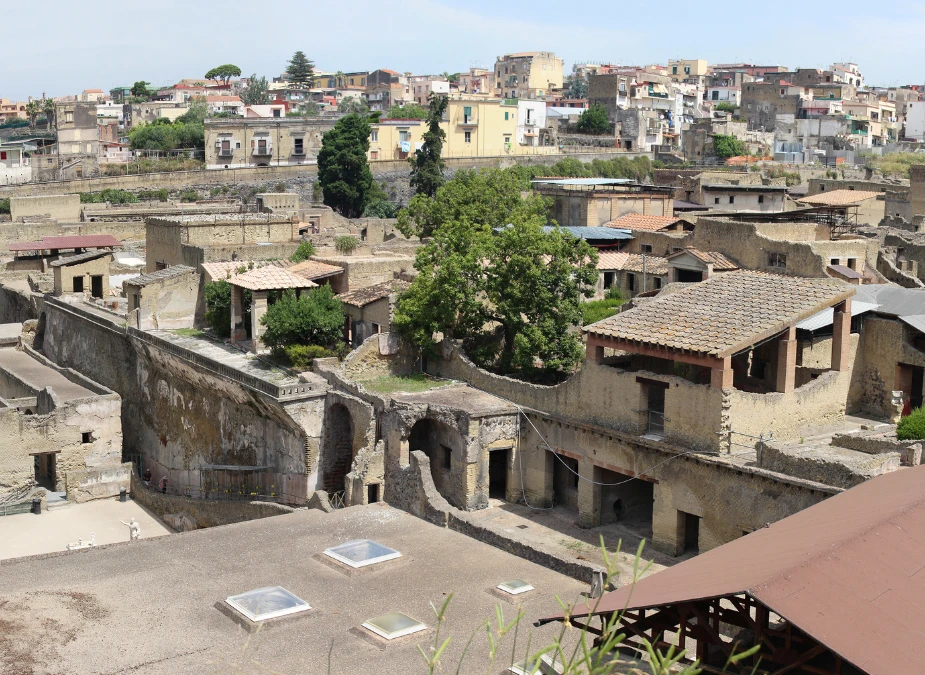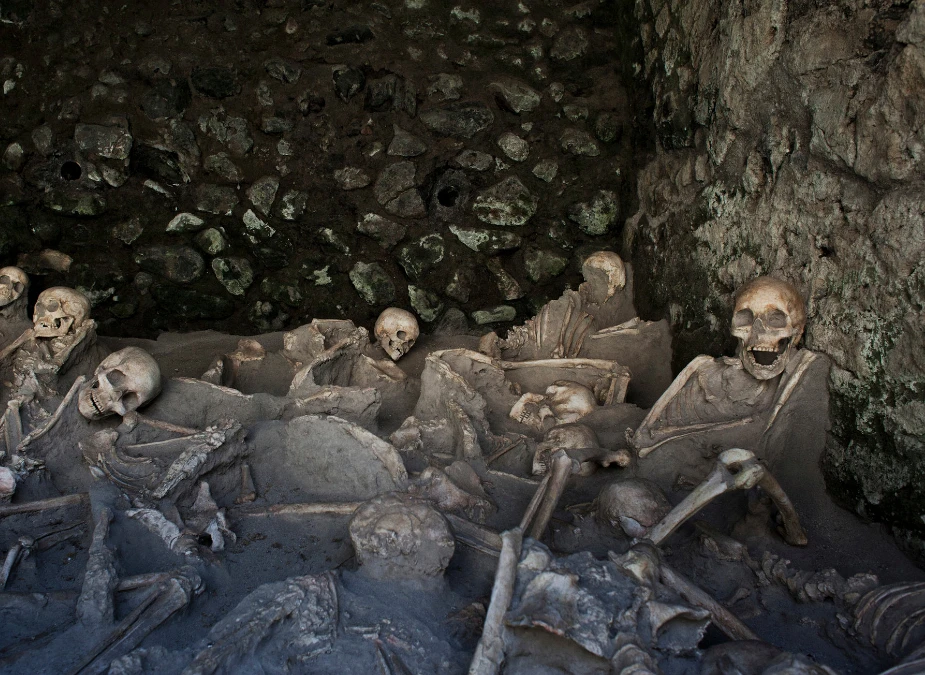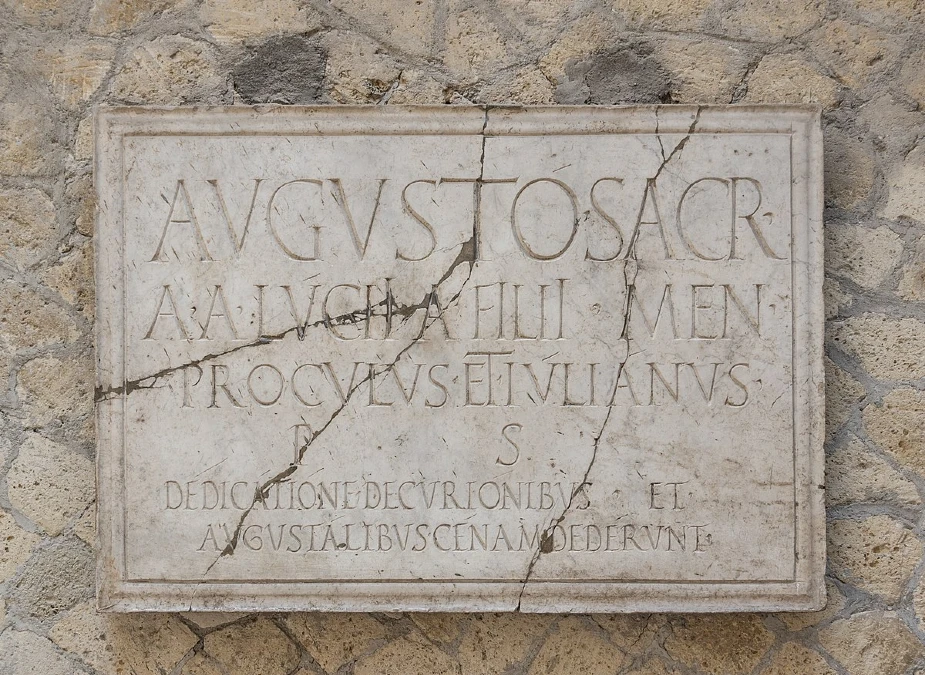Herculaneum was an ancient Roman town located on the Gulf of Naples in Italy.
It was destroyed and buried in ash and pumice when Mount Vesuvius erupted in 79 AD.
Unlike Pompeii, which was buried under a layer of ash and rock, Herculaneum was buried behind a thick layer of volcanic mud, creating an airtight cover over the ruins.
As a result, many artifacts and structures from the town, including wooden furniture and paintings, have been exceptionally well-preserved.
And even food that was being cooked when the eruption occurred.
This article will tell you everything about the ruins of Herculaneum, including their location, timing, and proximity to Pompeii.
About Herculaneum
Opening Hours: Herculaneum is open every day from 15 March to 15 October from 8.30 am to 7.30 pm and 8.30 pm to 5 pm from 16 October to 16 March.
Last Entry: 6 pm and 3.30 pm
Tickets: €50
Closed: Every Wednesday, May 1st, Christmas Day and New Year’s Day
Time Needed: 2 to 3 hours
Best Time to visit: Weekday mornings
Map of Herculaneum
The site is divided into three parallel streets running north-south (Cardo III, IV, and V) and two that run up and down (superiore and inferiore).
Two large east-west streets intersect each other.
After exiting the ticket building, you will go through a turnstile and follow the path beneath the site to the entrance.
The lengthy pathway entrance provides excellent views of the Roman town, with Mount Vesuvius in the background.
The ramp curves around the southern end, providing access to a metal ramp leading to a tunnel carved out of solid rock, which emerges at the old beach.
From here, you have a direct view of the coastal buildings, particularly the House of the Deer.
History and Excavations of Herculaneum Ruins

Although the city’s beginnings and how far back it goes are unclear, we do know that it was a commerce hub due to its closeness to the Gulf of Naples.
The hamlet was primarily controlled by Greeks before becoming a Roman city in 89 BC following the Social War.
It was named after the mythical Greek god Hercules, who established the city around 1243 BC, according to Dionysius of Halicarnassus.
After Mount Vesuvius erupted in 79 AD, Herculaneum was buried under 20 feet of ash, and it wasn’t discovered until 1709.
While fragments of the city were unearthed during previous earthworks, the entire city was discovered in 1709 while laborers were digging a well.
Regular excavations began in 1738; since then, opulent mansions, papyrus scrolls, and even well-preserved food have been discovered at the site.
Funds have been allocated to protect the previously uncovered areas of the village, and excavation has been halted for the time being.
What to See Inside Herculaneum
This archaeological park is ideal for those who have limited time. It offers the thrilling experience of walking in the footsteps of the ancient Romans.
Visitors can explore the ruins, including:
The House of Argus:

The House of Argus was one of the finer villas in the ancient Roman city of Herculaneum.
It was discovered in the late 1820s, which was notable as it was the first time a house in Herculaneum had been excavated.
Its name comes from a painting depicting Argus guarding Io, the nymph that was loved by Zeus and turned into a heifer.
The house featured a large peristyle garden surrounded by a colonnade.
Before the eruption of Mount Vesuvius in 79 AD, the House of Argus illustrates the luxurious lifestyle of Herculaneum’s upper class.
Its well-preserved ruins offer valuable insights into the ancient Romans’ architecture, art, and daily lives.
House of the Skeleton:

The House of the Skeleton in Herculaneum is a significant archaeological site within the ancient Roman town of Herculaneum.
This domus, or house, is known for the discovery of two splendidly decorated terrariums inside the structure.
The house likely derived its name from the discovery of skeletons within its premises, adding to the intrigue and historical significance of the site.
The House of the Skeleton in Herculaneum is a testament to the well-preserved ruins and artifacts found in the ancient town.
It offers valuable insights into its inhabitants’ daily lives and cultural practices.
Men’s Baths:
The Terme Centrale, or Central Baths, date back to the first century BC and were excavated in 1931.
The bathroom was divided into parts for men and women, with changing rooms, garment storage niches, and hot and cold rooms.
Double Atrium House:
The Mosaic Atrium House, located at the end of Cardo IV, features a black-and-white geometric mosaic that covers the entire atrium floor.
The partially excavated Palaestra, a spacious gymnasium accessible via a large vestibule from Cardo V, dominates the site’s eastern flank.
Built between 27 BCE and 14 CE, it has a portico with fluted Corinthian columns on three sides and a cryptoporticus on the north side to support the terrace above.
Multiple stores established near the monument cater to Palaestra visitors, offering various facilities, including a bakery (pistrinum).
Descending toward Cardo V Inferiore, near its intersection with Decumano Inferiore, are the ruins of a Thermopolis—an ancient cookshop that served food and beverages.
Hall of the Augustals:

The College of the Augustales is located in the northwestern corner of Cardo III Superiors.
The building’s interiors are adorned with legendary wall paintings that are frequently associated with Herculaneum’s imperial religion.
The gathering site could have been the municipal council, the local curia, or the Senate House.
Inside, you’ll find a large room with a modest shrine (sacellum) decorated with ‘fourth-style’ frescoes.
Hercules, Juno, and Minerva pose against the left wall.
The second wall depicts Hercules and Achelous, the gods of water and the world’s rivers, abducting Deianira.
The marble inscription on the wall depicts two brothers, Aulus Lucius Proculus and Aulus Lucius Iulianus, who gave a supper for the Decuriones and Augustales.
This occasion marked the dedication of an Augustus statue or shrine.
House of Neptune and Amphitrite:
It is thought to have belonged to a wealthy family because it is one of the most lavishly decorated buildings in Herculaneum, complete with vivid mosaics and a courtyard.
One of the mosaics here represents Neptune, the god of the sea, with his wife Amphitrite, which gives the house its name.
The Villa of Papyri
The Villa of the Papyri was an opulent house in Herculaneum. It was named after the discovery of extraordinary carbonized papyrus scrolls.
The scrolls miraculously survived being torched by volcanic ash and are now regarded as the last antique library.
Along with these scrolls, the mansion houses an outstanding collection of art, including marble sculptures and frescoes.
It houses the largest collection of Greek and Roman sculptures on one site.
It is claimed to have a garden, a vineyard, and a direct sea view from its terraces, which stretch 250 meters along the shoreline.
House of Relief of Telephus:

The House of the Relief of Telephus covers an area of approximately 1,800 square meters, making it one of the largest private residences in Herculaneum.
It is believed to have belonged to Marcus Nonius Balbus, a prominent citizen and patron of Herculaneum.
It gets its name from a high-quality sculptural relief in Pentelic marble discovered in one of the rooms, the Dieta.
The relief depicts the myth of Telephus, the son of Hercules.
The house features well-preserved frescoes, mosaics, and architectural details that provide insight into the lavish lifestyle of its wealthy owners.
The site also features the fornici, which were port warehouses used to shelter boats.
300 human skeletons, a nine-meter-long Roman ship, and a sphinx were found in these.
Accessibility at Herculaneum Ruins
The archaeological site of Herculaneum is accessible by wheelchair, with two paths on platforms and bathrooms accessible to people with disabilities.
Admission is free for people with disabilities and an accompanying person.
Skip-the-line tickets are valid for the whole day, allowing visitors to enter at any time.
In summary, the Ruins of Herculaneum offer a unique glimpse into the past with their remarkably preserved architecture and artifacts.
The site is accessible to visitors with disabilities and provides a thrilling experience of exploring an ancient Roman town.
Frequently Asked Questions About Herculaneum Ruins
1. Is the Herculaneum open now?
Herculaneum is open every day of the week except Wednesday, New Year’s Day (1 January), May 1st, and December 25th.
2. Is it worth visiting Herculaneum?
The ruins are smaller and less crowded than Pompeii, making for a more intimate exploration of the old streets and structures. It is a good alternative for people with limited time who want to explore a well-preserved Roman town.
3. How long do you need at Herculaneum Ruins?
To fully explore the Herculaneum ruins, spending about 2 to 3 hours at the archaeological site is recommended.
This timeframe allows visitors to see the majority of the ruins and delve into the history and significance of this ancient Roman town.
4. Are kids allowed to the Herculaneum ruins?
Visiting with little children might be challenging because the site’s historic Roman roads and walkways are tough to manage with strollers and pushchairs.
We recommend carrying an infant carrier or backpack for children who are too young to walk and leaving wheeled strollers at the free bag check location at the entrance.
5. How to reach Herculaneum ruins?
- If you travel by train, take the Circumvesuviana line and exit Ercolano Scavi station.
- From the Ercolano Scavi station, walk along Via 4 November for about 5 minutes to reach the entrance to the Herculaneum ruins.
- The Ercolano Scavi station is the closest stop to the archaeological site, making it a convenient starting point for your visit to Herculaneum
6. What is Herculaneum famous for?
Herculaneum is famous for its incredibly well-preserved ancient Roman ruins and artifacts, which provide a unique glimpse into daily life in an ancient city.
7. Is Herculaneum better or Pompeii?
Herculaneum offers a more immersive experience with its incredible preservation and compact layout, making it a better choice for many visitors.
But Pompeii remains a must-see for its historical significance.
8. What should I carry with me to Herculaneum?
You are only allowed to bring small bags, like backpacks, into Herculaneum. Large bags and bulky items over 30x30x15 cm are not permitted.
You can store larger bags in the free cloakroom at the ticket office.
9. Are the Herculaneum Ruins accessible by wheelchair?
Yes, the Herculaneum ruins are accessible by wheelchair.
The site offers wheelchair ramps, smooth pathways, and accessible bridges to explore many of the ancient streets, sidewalks, and buildings.
10. Are the Herculaneum Ruins free for people with disabilities?
People with impairments are exempt from paying the Herculaneum Ruins entry fee, and an accompanying individual receives free admission as well.
11. Is there a binding time for entrance tickets?
Skip-the-line tickets to the Herculaneum Ruins are valid for the entire day.
Remember, the ticket office closes 90 minutes before the official closing time, and the last admission is also 90 minutes before the closing time.
Featured Image:



